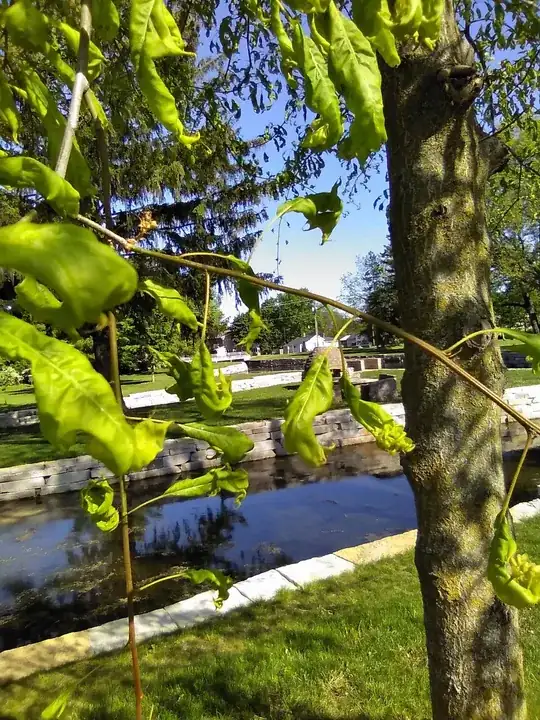Okay, I've checked the archives and can't find anything like this situation. In brief, the local idiots (I'm being charitable here, believe it or not) who run my city's Parks Dept vastly screwed up when spraying herbicide on two parks. They supposedly used a product called Tenkoz Lo-Vol 4, which comes in various formulations of 2, 4-D (the "Lo-Vol" in the name means "low volatility"); some of these formulations contain a petroleum oil as a surfactant. I do not believe that this is actually the only product in the tank that day, due to the weird damage to trees that I'm seeing.
Note: I apologize to my non-US friends in advance for using Imperial measurements, but I'm terrible at metric conversions.
Process
When applying the herbicide, they did the following:
- Used a Gator (small off-road vehicle) with a 55 gallon tank attached. This was attached to a boom that contained the spray nozzles.
- The boom was mounted on the back of the Gator, about 18 to 24 inches above ground. The nozzles at each end spray downward at about a 45 degree angle.
- They sprayed under and around the trees in the park, at times making very tight circles around the trunks.
- On the day of the application, the temperatures were about 60 F daytime and 45-50 F at night.
Results
- The park stank for about 10-12 days.
- All broadleaf weeds including creeping charlie (Glechoma hederacea) collapsed, as would be expected from a herbicide mix containing dicamba (as far as I know, 2, 4-D is ineffective against creeping charlie).
- All oak trees, including mature trees, showed terrible leaf damage - cupping and curling, with a leathery feel to them. See below:
 Entire small trees look like this or even worse - one is so bad that I can't actually identify its genus, although I suspect it's an oak. On the mature trees, this damage appeared up to a height of about 20 feet.
The affected trees were red and white oak, hackberry, white birch, hickory, green ash, sycamore or plane tree, and maple saplings; honey locusts were lightly affected. Unaffected trees are non-sapling maples of any species, basswood (Tilia americana and Tilia cordata) and crab apples. Sadly, of the small trees, only one 7" caliper red oak is showing any new growth. I believe that the others are just "dead trees standing". I can't do the bark test on the oaks because we have wilt in those parks.
Entire small trees look like this or even worse - one is so bad that I can't actually identify its genus, although I suspect it's an oak. On the mature trees, this damage appeared up to a height of about 20 feet.
The affected trees were red and white oak, hackberry, white birch, hickory, green ash, sycamore or plane tree, and maple saplings; honey locusts were lightly affected. Unaffected trees are non-sapling maples of any species, basswood (Tilia americana and Tilia cordata) and crab apples. Sadly, of the small trees, only one 7" caliper red oak is showing any new growth. I believe that the others are just "dead trees standing". I can't do the bark test on the oaks because we have wilt in those parks. - Drift from the herbicide moved out of the park and into our residential area, affecting trees up to 120 feet from the park. What's weird is that all herbaceous plants and some shrubs like privet, boxwood, and all evergreens were unaffected by this drift. If 2, 4-D was sprayed I'd've expected ALL plants to have been affected.
I suspect that some of the tree damage could've been caused by inadvertent basal bark spraying if the applicator used a product containing petroleum oil and a high enough concentration of herbicide.
The city is denying that they micalculated the amount of product used and says that it's normal for trees to wilt after an herbicide application. This is, of course, absolute crap if the spraying was done with the correct concentration of herbicide in the tank. Yes, they're lying to the people who live here. The city has also cancelled all public meetings where we citizens can ask questions and demand answers. Welcome to modern America...
My question - do any of you have an idea what herbicide or herbicides could actually have been used, given the selectivity of tree damage, amount of volatility from a non-volative formulation of 2, 4-D, and lack of drift damage to herbaceous plants? It seems unlikely to have been straight 2, 4-D, as that is non-selective - the drift should've hurt ALL plants that it touched, not just specific trees.
One thought from residents here is that they quite stupidly used an agricultural chemical called Banvel, which is 48.2% dicamba. This would explain the affects on oaks. The city's employees are of this mentality = "If my cousin Farmer Floyd has some left over in the barn then it's okay to use, right? We can then pocket the money budgeted for this!"
Location - southern Wisconsin, US, Zone 5b. Time of herbicide application - Mid-May.
Thanks for reading this very long question.
I'm hoping for "well, given that it became volatile at low temperatures and attacked these type of trees and didn't attack these other trees, then it may be X herbicide" kind of answers, or answers that can explain how a low volatility herbicide can become so volatile at such low temperatures that it rises 20 feet and flows 120 ft from the park. I am not expecting a definitive answer.